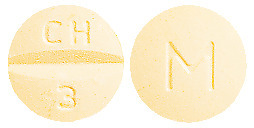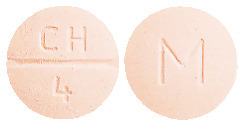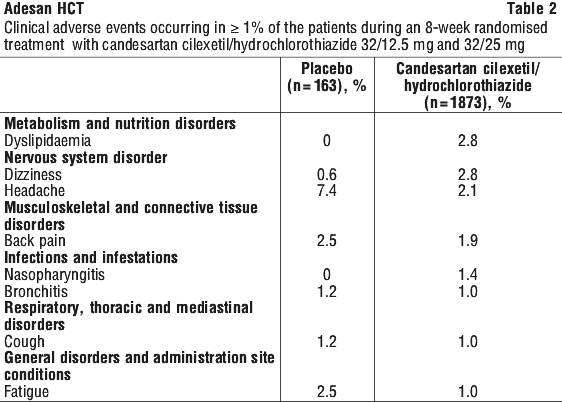SUMMARY CMI
ADESAN® HCT
Consumer Medicine Information (CMI) summary
The full CMI on the next page has more details. If you are worried about using this medicine, speak to your doctor or pharmacist.
1. Why am I using ADESAN HCT?
ADESAN HCT contains the active ingredient candesartan cilexetil and hydrochlorothiazide. ATACAND PLUS is used to treat high blood pressure. For more information, see Section 1. Why am I using ADESAN HCT? in the full CMI.
2. What should I know before I use ADESAN HCT?
Do not use if you have ever had an allergic reaction to candesartan cilexetil or hydrochlorothiazide or any of the ingredients listed at the end of the CMI.
Talk to your doctor if you have any other medical conditions, take any other medicines, or are pregnant or plan to become pregnant or are breastfeeding.
For more information, see Section 2. What should I know before I use ADESAN HCT? in the full CMI.
3. What if I am taking other medicines?
Some medicines may interfere with ADESAN HCT and affect how it works.
A list of these medicines is in Section 3. What if I am taking other medicines? in the full CMI.
4. How do I use ADESAN HCT?
- ADESAN HCT should be taken once daily with a glass of water, at about the same time each day.
- It does not matter whether you take ADESAN HCT with food or on an empty stomach
More instructions can be found in Section 4. How do I use ADESAN HCT? in the full CMI.
5. What should I know while using ADESAN HCT?
| Things you should do |
|
| Things you should not do |
|
| Driving or using machines |
|
| Drinking alcohol |
|
| Looking after your medicine |
|
For more information, see Section 5. What should I know while using ADESAN HCT? in the full CMI.
6. Are there any side effects?
All medicines can have side effects. If you do experience any side effects, most of them are minor and temporary. These include headache, nausea, flu-like symptoms, back pain, feeling tired or stomach ache. However, some side effects may need medical attention. These include rapid heartbeats, aching muscles, suspicious skin lesions, passing little urine, loss of appetite, decrease in vision or pain in your eyes or shortness of breath, fever, weakness and confusion. Serious side effects are rare. For more information, including what to do if you have any side effects, see Section 6. Are there any side effects? in the full CMI.
FULL CMI
ADESAN® HCT
Active ingredient(s): Candesartan cilexetil and hydrochlorothiazide
Consumer Medicine Information (CMI)
This leaflet provides important information about using ADESAN HCT. You should also speak to your doctor or pharmacist if you would like further information or if you have any concerns or questions about using ADESAN HCT.
Where to find information in this leaflet:
1. Why am I using ADESAN HCT?
2. What should I know before I use ADESAN HCT?
3. What if I am taking other medicines?
4. How do I use ADESAN HCT?
5. What should I know while using ADESAN HCT?
6. Are there any side effects?
7. Product details
1. Why am I using ADESAN HCT?
ADESAN HCT contains the active ingredient candesartan cilexetil and hydrochlorothiazide.
ADESAN HCT is used to treat high blood pressure.
Candesartan cilexetil is a type of medicine called an angiotensin II receptor antagonist (or blocker). It mainly works by causing relaxation of blood vessels.
Hydrochlorothiazide is a type of medicine called a diuretic. It works by reducing the amount of excess fluid in the body.
Using these two medicines together will lower your blood pressure more than using either one on its own.
2. What should I know before I use ADESAN HCT?
Warnings
Do not use ADESAN HCT if:
- you are allergic to any medicine containing candesartan cilexetil or hydrochlorothiazide, or any of the ingredients listed at the end of this leaflet, or any medicine containing an angiotensin II receptor antagonist (or blocker), or any sulphur drugs (sulphonamides) such as some antibiotics or some medicines to treat diabetes. Always check the ingredients to make sure you can use this medicine.
- you have gout.
- you have severe kidney or liver disease and/or conditions associated with impaired bile flow (cholestasis).
- you are taking blood pressure medicine containing aliskiren, especially if you have diabetes mellitus or have kidney problems.
Check with your doctor if you:
- have any allergies to any other medicines or foods.
- have any allergies to any other medicines or foods.
- kidney problems
- liver problems
- heart problems
- diabetes
- recent excessive vomiting or diarrhoea
- Systemic Lupus Erythematosus (SLE), a disease affecting the skin, joints and kidneys
- a salt restricted diet
- a condition called primary hyperaldosteronism
- a past operation known as sympathectomy
- a decrease in vision or eye pain. These could be symptoms of fluid accumulation in the vascular layer of the eye (choroidal effusion) or an increase of pressure in your eye and can happen within hours to weeks of taking ADESAN HCT. This can lead to permanent vision loss, if not treated. If you earlier have had a penicillin or sulphonamide allergy, you can be at higher risk of developing this. - experienced breathing or lung problems (including inflammation or fluid in the lungs) following hydrochlorothiazide intake in the past.
- have any questions about how you should be using your ADESAN HCT.
During treatment, you may be at risk of developing certain side effects. It is important you understand these risks and how to monitor for them. See additional information under Section 6. Are there any side effects?
Pregnancy and breastfeeding
Do not use ADESAN HCT if you are pregnant or are planning to become pregnant.
Check It may affect your baby if you take it during pregnancy.
Do not use ADESAN HCT if you are breastfeeding.
Your baby can take in components of ADESAN HCT from breast milk if you are breastfeeding.
Use in children
Do not give ADESAN HCT to children. There is no information about its use in children.
3. What if I am taking other medicines?
Some medicines and ADESAN HCT may interfere with each other. These include
- Other blood pressure lowering medicines, particularly diuretics (fluid tablets) and ACE-inhibitors, especially if you have diabetes-related kidney problems
- Medicines containing potassium, including salt substitutes
- Digoxin, a medicine used to treat heart failure
- Non-steroidal anti-inflammatory drugs (NSAIDs), medicines used to relieve pain, swelling and other symptoms of inflammation, including arthritis
- Colestipol and cholestyramine, medicines used to treat high blood cholesterol levels
- Lithium, a medicine used to treat mood swings and some types of depression
- Alcohol
- Strong pain killers such as codeine, morphine, dextropropoxyphene
- Barbiturates, such as phenobarbitone
- Medicines like insulin that are used to treat diabetes
- Calcium supplements or medicines containing calcium
- Vitamin D supplements
- Medicines to treat irregular heart beats
- Corticosteroids such as prednisone, cortisone, dexamethasone
- Laxatives
- Medicines used to treat cancer such as cyclophosphamide
- Methotrexate, a medicine used to treat arthritis and some cancers
- Amantadine, a medicine used to treat Parkinson's disease
- Ciclosporin
These medicines may be affected by ADESAN HCT or may affect how it works. You may need different amounts of your medicines or may need to take different medicines.
Check with your doctor or pharmacist if you are not sure about what medicines, vitamins or supplements you are taking and if these affect ADESAN HCT.
Your doctor and pharmacist have more information on medicines to be careful with or avoid while using this medicine.
4. How do I use ADESAN HCT?
How much to take
- The usual dose is one tablet once daily, taken whole with a glass of water.
- Follow the instructions provided and use ADESAN HCT until your doctor tells you to stop.
When to take
ADESAN HCT should be taken once daily, at about the same time each day.
Keeping a regular time for taking ADESAN HCT will help to remind you to take it.
It does not matter whether you take ADESAN HCT with food or on an empty stomach.
How long to take
ADESAN HCT helps control your condition, but does not cure it. Therefore, you must take ADESAN HCT every day. Continue taking the tablets for as long as your doctor tells you to.
If you forget to use ADESAN HCT
If you forget to take a dose, take it as soon as you remember, as long as it is at least 12 hours before your next dose is due.
Then go back to taking it as you would normally.
If it is less than 12 hours to your next dose, skip the dose you missed and take your next dose when you are meant to.
Do not take a double dose to make up for the dose you missed.
If you have trouble remembering when to take your medicine, ask your pharmacist for some hints.
If you use too much ADESAN HCT
If you think that you have used too much ADESAN HCT, you may need urgent medical attention.
You should immediately:
- phone the Poisons Information Centre
(Australia telephone calling 13 11 26), or - contact your doctor, or
- go to the Emergency Department at your nearest hospital.
You should do this even if there are no signs of discomfort or poisoning.
If you take too many ADESAN HCT tablets you may get a headache, feel sick (nausea), dizzy, thirsty and very tired.
5. What should I know while using ADESAN HCT?
Things you should do
Take ADESAN HCT exactly as your doctor has told you to.
Your blood pressure will not be well controlled if you do not.
If you are about to be started on any new medicine, remind your doctor and pharmacist that you are taking ADESAN HCT.
Tell your doctor if you have excessive vomiting or diarrhoea while taking ADESAN HCT.
You may lose too much water and your blood pressure may become too low.
- If you plan to have surgery (even at the dentist) that
- needs a general anaesthetic, tell your doctor or dentist
- that you are taking ADESAN HCT.
Tell your doctor if you plan to have an examination such as an X-ray or a scan requiring an injection of iodinated contrast (dye) that you are taking ADESAN HCT.
If you have had skin cancer or if you develop a suspicious skin lesion during treatment with ADESAN HCT, tell your doctor or pharmacist.
Treatment with hydrochlorothiazide, particularly long-term use with high doses, may increase the risk of some types of skin and lip cancer (non-melanoma skin cancer). Limit exposure to sunlight and protect your skin when exposed to sun while taking ADESAN HCT.
If you develop any severe shortness of breath or difficulty breathing after taking ADESAN HCT, seek medical attention immediately.
Call your doctor straight away if you:
- become pregnant or plan to become pregnant while you are taking ADESAN HCT. You should not use ADESAN HCT if you are pregnant or thinking about becoming pregnant. Your doctor can discuss different treatment options with you.
Remind any doctor, dentist or pharmacist you visit that you are using ADESAN HCT.
Be sure to keep all of your doctor's appointments so that your progress can be checked.
Your doctor will check your progress and may want to take some tests (e.g. blood tests, blood pressure) from time to time. These tests may help to prevent side effects.
Things you should not do
- Do not use it to treat any other complaints unless your doctor says to.
- Do not give this medicine to anyone else, even if they have symptoms that seem similar to yours.
- Do not stop taking ADESAN HCT unless you have discussed it with your doctor.
Things you should be careful of
- Move slowly when getting out of bed or standing up if you feel faint, dizzy or light-headed.
- Drink plenty of water while you are using ADESAN HCT, especially if you sweat a lot.
Please talk to your doctor or pharmacist about these possibilities if you think they may bother you.
Driving or using machines
Be careful before you drive or use any machines or tools until you know how ADESAN HCT affects you.
ADESAN HCT may cause dizziness when you start taking it due to the drop in your blood pressure.
Drinking alcohol
Tell your doctor if you drink alcohol.
Alcohol may interfere with ADEAN HCT.
Looking after your medicine
- Keep your tablets in the blister pack until it is time to take them.
- If you take ADEAN HCT out of the blister pack it will not keep well.
- Keep it in a cool, dry place where the temperature stays below 25°C.
Store it in a cool dry place away from moisture, heat or sunlight; for example, do not store it:
- in the bathroom or near a sink, or
- in the car or on window sills.
Keep it where young children cannot reach it.
Getting rid of any unwanted medicine
If you no longer need to use this medicine or it is out of date, take it to any pharmacy for safe disposal.
Do not use this medicine after the expiry date.
6. Are there any side effects?
All medicines can have side effects. If you do experience any side effects, most of them are minor and temporary. However, some side effects may need medical attention.
Tell your doctor or pharmacist as soon as possible if you do not feel well while you are taking ADESAN HCT.
See the information below and, if you need to, ask your doctor or pharmacist if you have any further questions about side effects.
Less serious side effects
| Less serious side effects | What to do |
| Speak to your doctor if you have any of these less serious side effects and they worry you. |
Serious side effects
| Serious side effects | What to do |
Allergic Reaction:
| Stop taking ATACAND PLUS and call your doctor straight away, or go straight to the Emergency Department at your nearest hospital if you notice any of these serious side effects. You may need urgent medical attention. Serious side effects are rare. |
Tell your doctor or pharmacist if you notice anything else that may be making you feel unwell.
Other side effects not listed here may occur in some people.
Reporting side effects
After you have received medical advice for any side effects you experience, you can report side effects to the Therapeutic Goods Administration online at www.tga.gov.au/reporting-problems. By reporting side effects, you can help provide more information on the safety of this medicine.
Always make sure you speak to your doctor or pharmacist before you decide to stop taking any of your medicines.
7. Product details
This medicine is only available with a doctor's prescription.
What ADESAN HCT contains
| Active ingredient (main ingredient) |
|
| Other ingredients (inactive ingredients) |
|
| Potential allergens |
|
Do not take this medicine if you are allergic to any of these ingredients.
What ADESAN HCT looks like
ADESAN® HCT 16/12.5 mg tablets - ADESAN HCT 16/12.5 tablets are peach colour, mottled, round, biconvex tablet debossed with “M” on one side and “CH2” on the other. (AUST R 163670)
ADESAN HCT 16/12.5 is available in blister packs of 7, 28 & 30's.
ADESAN® HCT 32/12.5 mg tablets - ADESAN HCT 32/12.5 tablets are yellow coloured, mottled, round, biconvex tablets debossed with “CH” above the break line and “3” below the break line on one side of the tablet and “M” on the other side. (AUST R 206485)
ADESAN HCT 32/12.5 is available in blister packs of 7 & 30's.
ADESAN® HCT 32/25 mg tablets - ADESAN HCT 32/25 tablets are peach coloured, mottled, round, biconvex tablets debossed with “CH” above the break line and “4” below the break line on one side of the tablet and “M” on the other side. (AUST R 206486)
ADESAN HCT 32/25 is available in blister packs of 7 & 30's.
Who distributes ADESAN HCT
Alphapharm Pty Ltd trading as Viatris
Level 1, 30 The Bond
30-34 Hickson Road
Millers Point NSW 2000
www.viatris.com.au
Phone: 1800 274 276
This leaflet was prepared in December 2022
ADESAN® is a Viatris company trade mark
ADESAN HCT_cmi\Dec22/00
Published by MIMS March 2023




 The following clinical adverse events occurred with a frequency of 0.5% to < 1% with no occurrence in the placebo group: A-V block, vomiting.
The following clinical adverse events occurred with a frequency of 0.5% to < 1% with no occurrence in the placebo group: A-V block, vomiting.
 Chemical name: (±)-1-(cyclohexyloxycarbonyl-oxy) ethyl 2-ethoxy-1-[[2'-(1H-tetrazol-5-yl) biphenyl-4-yl] methyl]-1H-benzimidazole-7- carboxylate.
Chemical name: (±)-1-(cyclohexyloxycarbonyl-oxy) ethyl 2-ethoxy-1-[[2'-(1H-tetrazol-5-yl) biphenyl-4-yl] methyl]-1H-benzimidazole-7- carboxylate. Chemical name: 6-chloro-3,4-dihydro- 2H-1,2,4-benzothiadiazine-7-sulphonamide 1, 1-dioxide.
Chemical name: 6-chloro-3,4-dihydro- 2H-1,2,4-benzothiadiazine-7-sulphonamide 1, 1-dioxide.